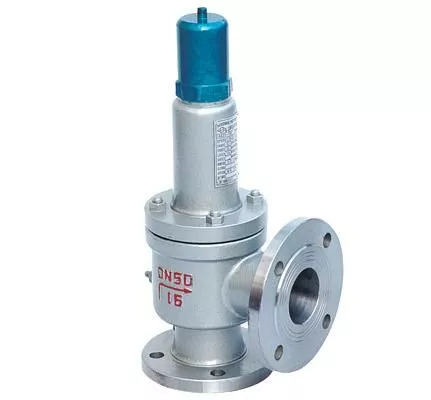Structure of safety valves mainly has two types: spring type and lever type. Spring type safety valves refer to that the sealing between disc and seat is depending on force of spring. Lever type safety valves depend on applied force of lever and heavy hammer. For the demands for large capacity, pulsed safety valves, also called as piloted operated safety valves come out, which consist of main relief valve and auxiliary valve. When pressure of media inside pipe exceeds than specified pressure value, auxiliary valve opens firstly. Media enter into main relief valve along the conduit and open the main relief valve, then, the increasing media pressure is decreased.
Emission of safety valves is decided by caliber of seat and opening height of disc. According to this, safety valves can be divided into low lift safety valves (opening height is 1/20~1/40 of caliber of seat) and full open safety valves (opening height is 1/3~1/4 of caliber of seat).
In addition, based on different requirements for utilization, safety valves also can be divided into sealing type and non-sealing type. Sealing type valves refer to that exhausted media do not leak out. All of media are exhausted from the specified exit. Sealing safety valves are generally used for toxic or corrosive media. Non-sealing safety valves are commonly used for non-toxic or non-corrosive media.
Based on different over-all structures and loading mechanisms, safety valves are classified into heavy duty lever type safety valves, spring type safety valves and pulsed safety valves.
The structure of heavy duty lever type safety valves is simple so that the valves can be regulated easily and precisely. Applied load cannot grow largely with disc elevating. The valves are suitable for occasions where having higher temperature. Heavy duty lever type safety valves are commonly applied in the past, particularly applied in boiler and pressure vessel having higher temperature. However, heavy duty lever type safety valves have heavier structure. Loading mechanisms are vibrated easily, which usually result in leakage because of vibration. Reseating pressure is lower which is not easy for being closed after opening and keeping sealing.
2. Spring low lift safety valves
Spring low lift safety valves use force compressing spring to balance the force applied on disc.
Amount of compression of spiral spring can be adjusted through rotating adjusting nut on spring low lift safety valves. Using the structure can rectify opening pressure (or set pressure) of safety valves based on requirements. Spring low lift safety valves have light and compact structure and higher sensitivity. Mounting position is not limited. Besides, for lower sensitivity to vibration, the valves can be used for mobile pressure vessel. The disadvantage of spring low lift safety valves is that applied load changes with valve opening changing. With disc lifting, compression of spring is also growing and force applied on disc is also increasing, which are disadvantageous for safety valve rapidly opening. Moreover, elastic force decrease for spring on valves being influenced high temperature for a long term. When applied on vessel having high temperature, thermal insulation or heat dissipation of spring is usually considered, making structure more complicated.
3. Pulsed safety valves
Pulsed safety valves consist of main relief valve and auxiliary valve. Main relief valve is driven by impulse of auxiliary valve. Due to complicated structure, pulsed safety valves are only suitable for boiler and pressure vessel having high safety discharge capacity.
Above three types of
safety valves, spring safety valves are more commonly used.

